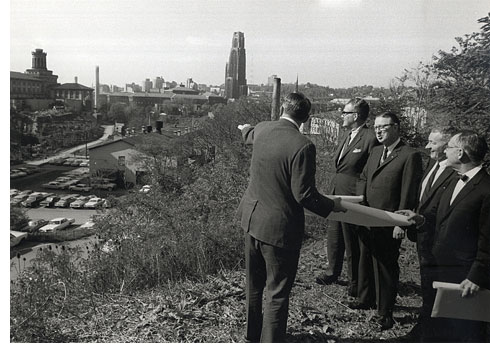
- All Photos: © Carnegie Mellon University Archives, all rights reserved.
Shown in the top two photos making the announcement are Carnegie-Mellon President H. Guyford Stever; Aiken Fisher, chairman of the board of trustees; Frederick Bloom, chairman of the trustees' building and grounds committee; Fred Foy, chairman of the university's Fund for Distinction; and Walton Forstall, professor of mechanical engineering and faculty representative on the planning committee.
The building was designed by the Pittsburgh firm Deeter Ritchey Sippel, better known as architects of Mellon Arena and the former Three Rivers Stadium.
Renamed "Science Hall," the building opened in May 1971. A decade later, it was rededicated in honor of Raymond J. Wean Sr. (E'17), a pioneering engineer, distinguished alumnus and emeritus life trustee of the university.
The university has scheduled a Sept. 22 dedication for its latest ambitious building project --- the Gates Center for Computer Science and Hillman Center for Future-Generation Technologies.
Web Extras
Photo No. 3 shows the site of Science Hall prior to the start of construction.
Photos No. 4 and 5 show progress in mid-1969, as Science Hall's poured concrete walls began to take shape.
In photo No. 6, taken Sept. 23, 1969, faculty and student protesters have blocked construction crews and material from reaching the Science Hall site.
The protesters were acting in conjunction with the Black Construction Coalition of Pittsburgh, which was unhappy over the lack of African-Americans working on the Science Hall project.
Carnegie-Mellon President Stever had ordered a one-day halt to construction at Science Hall and Margaret Morrison Plaza on Sept. 22, 1969 after meeting the previous weekend with faculty and students to hear their concerns about the absence of jobs for minorities.
Construction was scheduled to resume the following day, but about 500 demonstrators in three groups blocked roads and turned back trucks delivering concrete and other materials.
The CMU projects weren't the only ones protested --- the Black Construction Coalition also shut down the construction of Three Rivers Stadium over segregation in the building trade unions.
Eventually, Carnegie-Mellon officials went to Allegheny County Common Pleas Court to seek an injunction to block future demonstrations --- and warned students that they could face disciplinary action for "disrupting the normal operation of the university."
But the demonstrations did result in positive action. Stever pressed President Nixon and the U.S. Department of Justice to investigate a lack of equal opportunities for African-Americans in trade unions, and instructed the university's attorneys to renegotiate construction contracts to ensure that minority workers were recruited onto the projects.
The last photo --- No. 7 --- shows construction progress at Science Hall during the winter of 1969-70.
Image2:

Image3:

Image4:

Image5:

Image6:

Image7:

For More Information:
Jason Togyer | 412-268-8721 | jt3y@cs.cmu.edu

